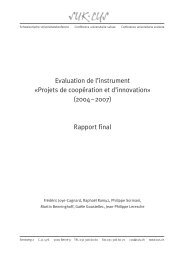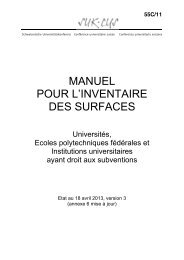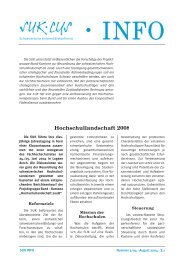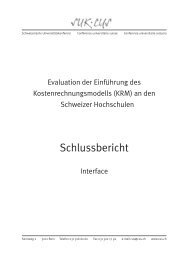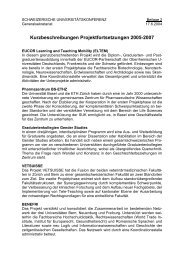Evaluation of the Swiss Virtual Campus - Schweizerische ...
Evaluation of the Swiss Virtual Campus - Schweizerische ...
Evaluation of the Swiss Virtual Campus - Schweizerische ...
You also want an ePaper? Increase the reach of your titles
YUMPU automatically turns print PDFs into web optimized ePapers that Google loves.
SVC Final <strong>Evaluation</strong>. Background Report Lepori and Probst<br />
contributed to <strong>the</strong> expected wider diffusion <strong>of</strong> elearning, beyond <strong>the</strong> few projects <strong>of</strong> <strong>the</strong> impulse<br />
phase.<br />
Our analysis shows that all <strong>Swiss</strong> higher education institutions managed to establish a centre <strong>of</strong><br />
competence in <strong>the</strong> SVC programme. However, a more in-depth analysis shows that <strong>the</strong>re are<br />
quite wide differences concerning <strong>the</strong> role and structure <strong>of</strong> <strong>the</strong>se centres and <strong>the</strong>ir future<br />
perspectives.<br />
Roughly speaking, we can distinguish between three types <strong>of</strong> situation:<br />
• The centres which have found a stable organizational position and are nowadays largely<br />
recognized as <strong>the</strong> support unit for elearning, meaning also that <strong>the</strong>ir services are used by a<br />
large share <strong>of</strong> teachers (for example a large share <strong>of</strong> courses is hosted by <strong>the</strong> learning<br />
management system (LMS) <strong>of</strong>fered by <strong>the</strong> CCSP). Normally, behind <strong>the</strong>se centres <strong>the</strong>re is<br />
also a clear strategy <strong>of</strong> <strong>the</strong> university and explicit support by <strong>the</strong> rectorates. This includes<br />
Zurich, Basel, Sankt Gallen, <strong>the</strong> USI-SUPSI joint CCSP, Fribourg, <strong>the</strong> Federal Institutes <strong>of</strong><br />
Technology (even if <strong>the</strong>y didn’t receive SVC funding), Lausanne, <strong>the</strong> Hochschule Luzern<br />
and <strong>the</strong> Haute Ecole Spécialisée de Suisse occidentale.<br />
• A number <strong>of</strong> centres that possess some basic structure and funding, but are less firmly<br />
established than <strong>the</strong> previous ones. Even if <strong>the</strong> distinction with <strong>the</strong> previous category is not<br />
clear-cut, this list could include two universities where <strong>the</strong> development <strong>of</strong> a CCSP has<br />
been made difficult by conflicting interests, namely Geneva and Bern, where <strong>the</strong> decision to<br />
continue was taken just at <strong>the</strong> end <strong>of</strong> 2007. The list could also include <strong>the</strong> Zürcher<br />
Fachhochschule and <strong>the</strong> Berner Fachhochschule, where <strong>the</strong> situation is made more difficult<br />
because <strong>of</strong> <strong>the</strong> lack <strong>of</strong> a central strategy on elearning.<br />
• Finally, <strong>the</strong>re are some difficult cases where <strong>the</strong> existence <strong>of</strong> a centre cannot now be<br />
ensured: <strong>the</strong> University <strong>of</strong> Neuchâtel where a decision on continuation and funding has yet<br />
to be taken, Lucerne where <strong>the</strong> centre has been outsourced to <strong>the</strong> pedagogical school <strong>the</strong><br />
Fachhochschule Nordwestschweiz, where <strong>the</strong> existing centre will be closed and elearning<br />
will be decentralised in <strong>the</strong> departments, and <strong>the</strong> Fachhochschule Ostschweiz, where <strong>the</strong><br />
situation is unclear due to <strong>the</strong> lack <strong>of</strong> a central structure in <strong>the</strong> UAS.<br />
From interviews, it emerges that <strong>the</strong> SVC, through its funding but also <strong>the</strong> monitoring, has been<br />
a strong promoting force to establish university competence centres; this was especially <strong>the</strong><br />
case where <strong>the</strong>se structures did not exist before, like in Sou<strong>the</strong>rn Switzerland, and for some<br />
universities where federal intervention forced competing actors to find a form <strong>of</strong> cooperation to<br />
establish a single network with some central coordinating unit.<br />
Moreover, in a number <strong>of</strong> cases <strong>the</strong> SVC projects acted as gatekeeper to introduce for <strong>the</strong> first<br />
time sizeable elearning activities in <strong>the</strong> institution and thus to raise <strong>the</strong> rectorates’ awareness <strong>of</strong><br />
<strong>the</strong> importance <strong>of</strong> <strong>the</strong> issue. Some interviewed people remarked that <strong>the</strong> large number <strong>of</strong> <strong>the</strong>se<br />
projects and <strong>the</strong> sheer size and visibility <strong>of</strong> <strong>the</strong> SVC programme as a whole acted as a strong<br />
incentive to university directorates to take some action in this field. In some cases,<br />
competences developed in projects have also become <strong>the</strong> basis for <strong>the</strong> establishment <strong>of</strong> CCSP.<br />
The following table provides a short overview <strong>of</strong> <strong>the</strong> organization <strong>of</strong> <strong>the</strong> different CCSPs. For<br />
more detailed descriptions see <strong>the</strong> tables in <strong>the</strong> annex.<br />
22





